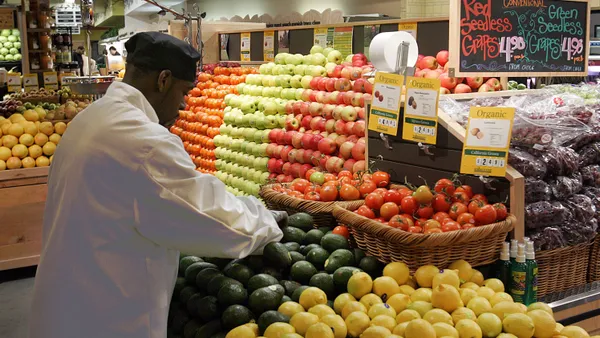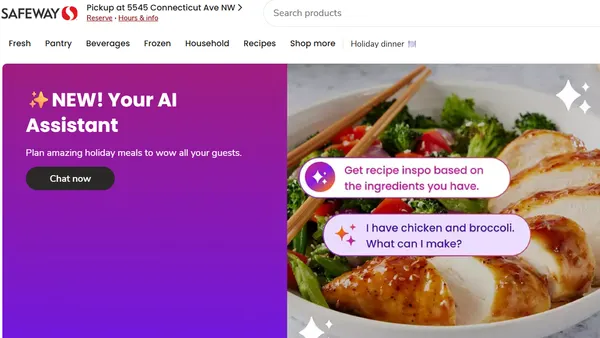Dive Brief:
- Grocery CEOs ranked continued growth of e-commerce and making digital channel sales profitable as top trends shaping the industry in 2021, according to a survey by The Food Industry Association (FMI) and McKinsey & Company.
- Out of more than 40 grocery CEOs surveyed, 53% listed online grocery's ongoing growth in their top three priorities for the industry and 38% picked e-commerce profitability. Survey respondents also said the increasing roles of technology and pressures on pricing are among the biggest trends shaping the industry this year.
- The opportunities and challenges executives see in digital come as year-over-year online sales have begun to decline steeply.
Dive Insight:
Grocery CEOs’ focus on e-commerce sales and profitability comes at a time when the industry is coming down from the online shopping surge brought on by the coronavirus pandemic but still facing elevated long-term shopping in the channel.
Going forward, online grocery sales are expected to reach a new baseline, accounting for 10%-11% of overall grocery sales, said Bill Aull, partner with McKinsey & Company.
The survey, which is part of the latest "State of Grocery" report for North America that Aull previewed during FMI's Midsummer Strategic Executive Exchange on Tuesday, found that 87% of CEOs listed continued growth of e-commerce as one of their top 5 trends for 2021, while 69% reported the same for digital profitability.
In a discussion of grocery trends during the FMI session, Vivek Sankaran, president and CEO of Albertsons, said consumer adoption of e-commerce likely won't reverse. “The desire to shop and the convenience of having something delivered at home or put in the trunk of your car is incredible, and I think consumers never give convenience back,” he said.
Additionally, Sankaran said he expects more digital engagement from shoppers as grocers boost personalized offers, along with a continued focus on remote work, which could have a "massive" impact on the food and beverage industries as more companies adjust policies and workers continue to seek flexible schedules.
To improve digital profitability, grocers are adding automated systems to increase the speed and accuracy of order assembly. They're also moving order picking off the retail floor, where workers busily grabbing products can diminish the shopping experience for consumers. Kroger, most notably, has begun its closely-watched rollout of large automated fulfillment centers, which are now live in Ohio and Florida.
FMI and McKinsey’s research also included a survey of 5,000 shoppers, most of whom say they plan to continue spending the same or more at grocery stores than before the pandemic. However, 31% said they will decrease spending on meal kit services and 26% said the same for grocery delivery. That tracks with recent research from Brick Meets Click and Mercatus showing that grocery e-commerce sales declined 16% year-over-year in May.
The shopper input indicates consumers are settling into a new grocery routine that combines some of the habits established during the pandemic, while shedding others. After reducing their number of stores visited per week by 43% in 2020 compared to pre-COVID times, consumers said they expect their frequency of grocery purchases and the number of stores visited to be about the same this year as during the pandemic.
“While pre-pandemic we were seeing [a] significant number of two- and three-stop shops over the course of a week, we are still seeing reduced intent across shopping frequency from consumers as we move into 2021,” Aull said.
Reducing spending is another big focus for consumers: Forty-five percent said they plan to look for more ways to save money when shopping, with the survey noting that there’s increasing interest in seeking the “best promotions,” switching to less expensive products and consolidating shopping at large stores. Healthy eating and nutrition also are increasingly top of mind for shoppers, the research found.












